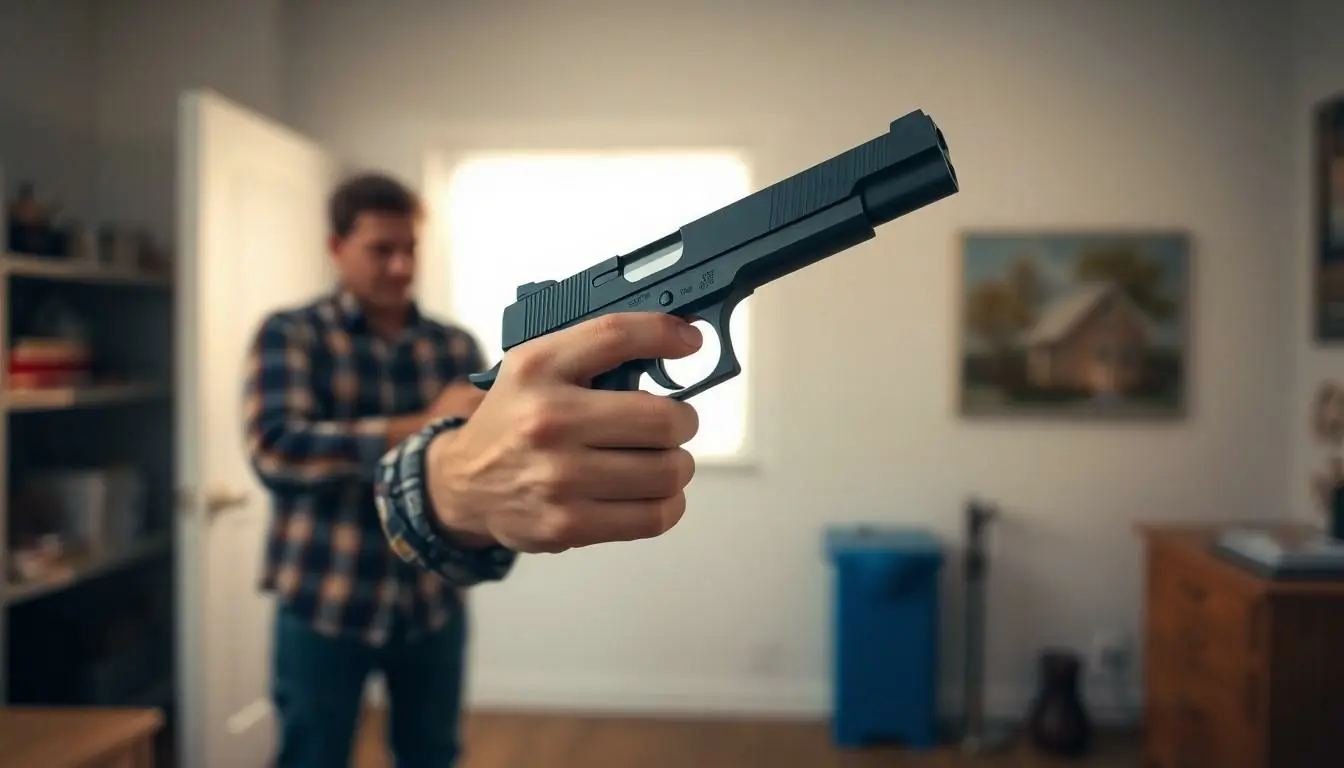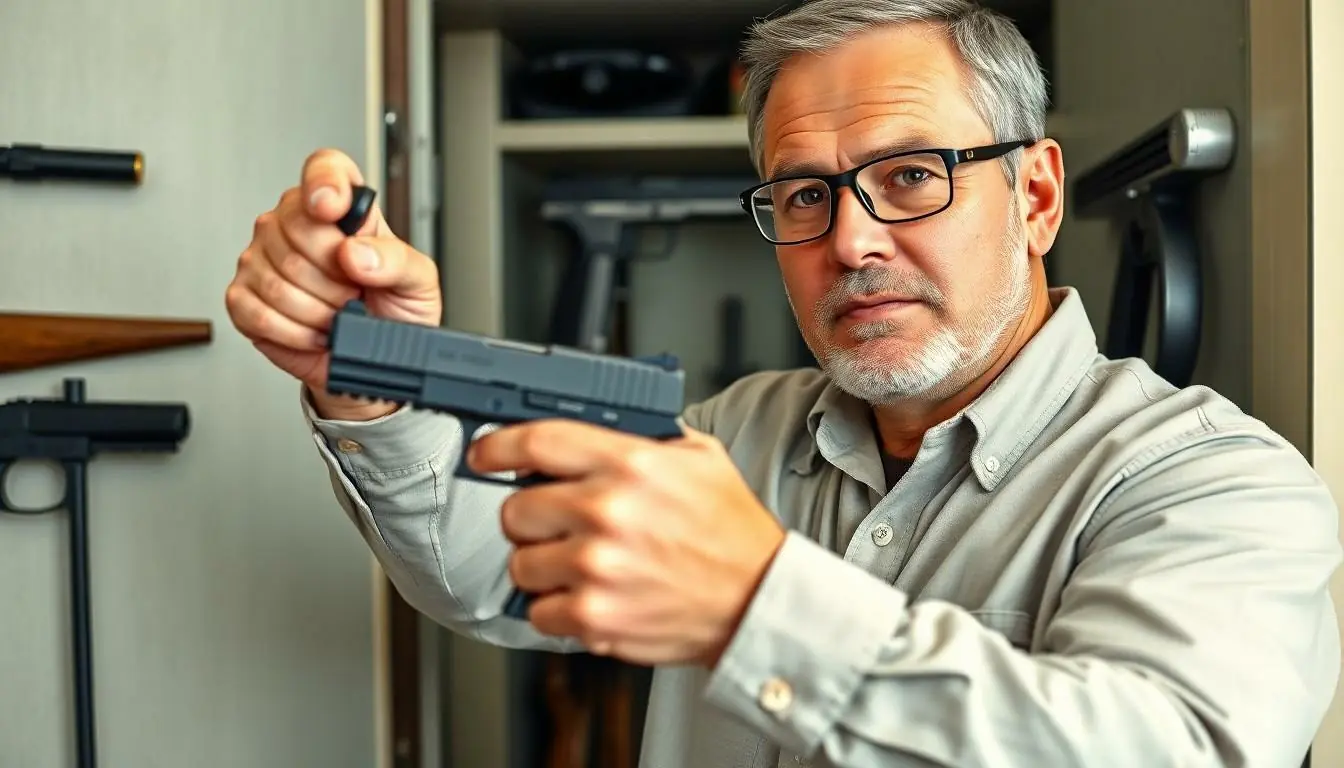Handling a firearm at home isn’t just about knowing where it’s stored; it’s about mastering the art of safe and responsible interactions. Picture this: you’ve just removed your trusty sidekick from its cozy hiding spot, and now what? It’s time to channel your inner action hero, but with a dash of caution and a sprinkle of common sense.
Table of Contents
ToggleUnderstanding Firearm Safety
Safe handling of firearms requires awareness and responsibility. Knowledge and skills play critical roles in ensuring safety during interactions with firearms.
Importance of Firearm Safety
Firearm safety protects lives. Proper handling reduces risks of accidental discharges. Everyone involved benefits when firearms are treated with respect and care. Familiarity with safety practices promotes confidence in responsible ownership. Education on safe mechanisms and storage increases preparedness during critical moments. Comprehensive training includes understanding firearm operation and recognizing potential hazards. The importance of safety transcends personal responsibility, impacting family and community safety.
Legal Considerations
Legal implications surround firearm ownership and handling. Laws vary by state, encompassing storage, transportation, and usage. Understanding local statutes ensures compliance and prevents legal issues. Responsible owners often educate themselves on regulations governing safe practices. Violating laws can lead to severe consequences, including fines and imprisonment. Critical aspects include securing firearms from unauthorized access and following proper protocols during transfer. Knowledge of legal requirements reinforces responsible behavior and discourages negligence.
Steps to Follow When Removing a Firearm

Handling a firearm requires a meticulous approach. Adhering to specific steps ensures safety and responsibility throughout the process.
Assessing the Environment
Before removing a firearm, examining the surrounding area is crucial. Look for any potential hazards that may pose a risk during handling. Ensure that children, pets, or any distractions are not present. Secure a clear, quiet space for firearm handling, minimizing the chance of accidental discharges. Observing the environment beforehand establishes a safe zone for managing the firearm.
Ensuring the Firearm is Unloaded
Always check that the firearm is unloaded before handling it. Remove the magazine, then pull back the slide to check the chamber for any remaining rounds. Confirming the firearm is empty guarantees a reduced risk during handling. Treat the firearm as if it is loaded regardless of whether it has been verified empty. This mindset reinforces a culture of safety and responsibility among firearm owners.
Proper Handling Techniques
Safe firearm handling requires careful attention and adherence to specific techniques. Following these guidelines helps reduce risks associated with firearms.
Grip and Control
Achieving a proper grip on the firearm is fundamental for effective control. Start by using both hands; the dominant hand should grasp the grip, while the supportive hand wraps around the other side. Maintain a firm, yet relaxed grip to avoid fatigue. Keeping fingers off the trigger until ready to fire is essential. This prevents accidental discharges. Adjust your stance to provide stability and balance; feet should align slightly wider than shoulder width for optimal control. Confirm the firearm fits comfortably in hand; unsuitable sizes can hinder safe handling.
Avoiding Muzzle Discipline
Maintaining muzzle discipline is vital for safety and responsible handling. Always point the firearm in a safe direction, away from people and objects. This minimizes risks if an accidental discharge occurs. Constantly be aware of where the firearm is aimed, regardless of circumstances. Positioning the muzzle downrange or toward a designated safe area establishes clear discipline. When not dealing with a target, avoid sweeping the muzzle across others. Keeping the firearm in a controlled space promotes safety and reassures those around. Practicing these techniques reinforces a culture of responsibility among firearm owners.
Storage and Securing the Firearm
Proper storage and securing of firearms play a crucial role in ensuring safety within the home environment. Recognizing the importance of responsible handling is essential for every firearm owner.
Temporary Storage Options
Temporary storage options should always prioritize safety. Quick access safes serve as a popular choice, allowing for rapid retrieval while ensuring security. Lockboxes directly provide a safe alternative, preventing unauthorized access. In cases where immediate need arises, designing dedicated storage areas that are both secure and easily reachable will enhance safety. Firearms must always remain locked away when not in active use, especially in homes with children or visitors.
Long-Term Storage Considerations
Long-term storage considerations require strategic planning. Utilizing a climate-controlled safe protects firearms from moisture and temperature fluctuations. Adding dehumidifiers to the safe can further mitigate humidity levels and preserve firearm integrity. It’s crucial to consider proper maintenance procedures, such as regular cleaning to prevent corrosion. Furthermore, using gun socks or padded cases provides additional protection when storing firearms for extended periods. Firearm owners must also maintain an updated log, tracking inventory and condition for greater accountability.
Handling a firearm safely requires vigilance and respect. By following proper procedures when removing a firearm from storage, individuals can significantly mitigate risks. Awareness of one’s surroundings and ensuring the firearm is unloaded are critical steps in this process.
Education on local laws and safe handling techniques fosters a culture of responsibility that benefits everyone. Responsible firearm ownership isn’t just about compliance; it’s about ensuring the safety of oneself and others. By committing to safe practices, individuals not only protect their families but also contribute to a safer community.

